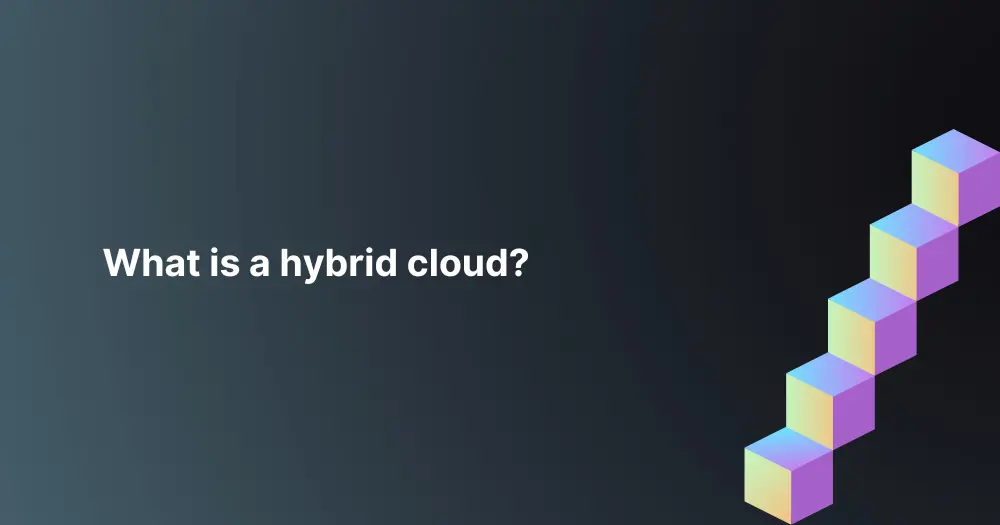
Organizations had to decide between public and private cloud systems to satisfy their IT requirements in the early days of cloud computing. However, as organizations began to recognize the limitations and challenges associated with relying solely on one type of cloud, the hybrid cloud emerged as a viable solution. Combining the best aspects of public and private clouds, the hybrid cloud model offers businesses unprecedented flexibility, scalability, and security. This innovative approach enables organizations to optimize their IT infrastructure by seamlessly integrating public and private environments, addressing the unique demands of today’s fast-paced digital landscape.
Organizations had to decide between public and private cloud systems to satisfy their IT requirements in the early days of cloud computing. However, as organizations began to recognize the limitations and challenges associated with relying solely on one type of cloud, the hybrid cloud emerged as a viable solution. Combining the best aspects of public and private clouds, the hybrid cloud model offers businesses unprecedented flexibility, scalability, and security. This innovative approach enables organizations to optimize their IT infrastructure by seamlessly integrating public and private environments, addressing the unique demands of today’s fast-paced digital landscape.
An environment for computing known as a “hybrid cloud” comprises public and private clouds, allowing data and applications to be shared between them. This approach provides businesses with more deployment options and flexibility in managing their workloads. Let us take a closer look at the components of a hybrid cloud:
Public cloud is a service offered by third-party providers over the Internet. These companies give pay-as-you-go access to computer resources such as virtual machines, storage, and software. Google Cloud Platform, Amazon Web Services (AWS), and Microsoft Azure are among the most well-known providers of public cloud services, and their prominence is widely acknowledged.
A private cloud is an infrastructure only used by one company, on-site, or hosted by a different company. Private clouds offer businesses more control over their data and resources and enhanced security and compliance. They benefit organizations with strict regulatory requirements or sensitive data that cannot be stored on the public cloud.
It is essential to differentiate the hybrid cloud from other cloud models such as public, private, and multi-cloud. While public and private clouds are stand-alone solutions, a hybrid cloud combines both in a single environment. On the other hand, a multi-cloud strategy involves using multiple public cloud providers but not necessarily integrating them with a private cloud.
Adopting a hybrid cloud strategy offers numerous advantages for businesses, including:
A hybrid cloud allows organizations to optimize their IT spending by leveraging the pay-as-you-go model of public clouds for non-sensitive workloads and using private clouds for more critical tasks. This approach prevents overprovisioning and helps businesses avoid large capital expenditures on hardware and software.
With a hybrid cloud, businesses can quickly scale their computing resources up or down based on demand. Public clouds offer virtually unlimited resources, enabling organizations to handle unexpected spikes in traffic or seasonal fluctuations without investing in additional infrastructure. Additionally, the flexibility of the hybrid cloud allows businesses to choose the best environment for each workload, ensuring optimal performance and efficiency.
By integrating a private cloud into their infrastructure, businesses can maintain greater control over sensitive data and applications, ensuring compliance with industry regulations and data protection laws. Organizations may use a hybrid cloud to deploy cutting-edge security features across public and private environments, like encryption and access restrictions.
A hybrid cloud strategy can significantly improve a business’s ability to recover from disasters and ensure continuity of operations. By distributing workloads and data across multiple environments, organizations can minimize the risk of downtime due to hardware failures, cyberattacks, or natural disasters. The distribution of workloads allows for outages to not impact the entire business operation but only portions of it.
When selecting a hybrid cloud solution, businesses should consider the following factors:
Before starting a hybrid cloud journey, organizations should assess their needs, strategic goals, and future demands. This assessment will help them identify the workloads best suited for public or private cloud environments and determine the right mix of resources.
Researching and comparing different cloud providers is essential to find one that aligns with your business’s requirements and budget. Consider elements like the variety of services provided, performance, security features, and migration and integration help.
When evaluating hybrid cloud solutions, businesses should consider the costs, performance, compatibility with existing systems, and the level of support the vendor provides. A successful hybrid cloud implementation requires seamless integration between public and private environments, so ensuring that the chosen solution meets these requirements is crucial.
To create a successful hybrid cloud strategy, businesses should follow these steps:
Develop a Plan
Create a detailed plan outlining your objectives, timelines, and resource requirements. This plan should include an assessment of your existing infrastructure, identifying workloads to be migrated, and a roadmap for implementation.
Migrate Workloads and Applications
Once you have a plan, begin migrating your workloads and applications to the appropriate cloud environments. This process may involve refactoring or re-architecting applications to ensure optimal performance in the new environment.
Ensure Seamless Integration
Ensuring seamless integration between your public and private cloud environments is crucial. This may involve setting up secure connections, implementing consistent management tools, and establishing monitoring and reporting processes across both environments.
Monitor and Optimize
After implementing your hybrid cloud strategy, continually monitor and optimize your environment to ensure it meets your business objectives. Regularly review your resource utilization, costs, and performance metrics to identify areas for improvement or potential savings.
Discover the benefits of hybrid cloud with BlackPoint IT‘s tailored cloud solutions. Our experienced team will guide you through strategy development, infrastructure assessment, workload migration, and seamless integration between public and private clouds. We also provide ongoing monitoring, optimization, and support to ensure your business stays agile, secure, and competitive in today’s digital landscape. Keep the complexities of the hybrid cloud from holding you back. Contact BlackPoint IT today to help us unlock your business’s full potential.